Chatham Street Chapel (1834)
Introduction
Text-to-speech Audio
Chatham Street Chapel was first opened as Chatham Garden Theatre, or else known as Chatham Theatre in May 1824, located at the Chatham Gardens in Lower Manhattan, New York City. During the early period of the Theatre’s activity, the structure was mainly involved in displaying performances and musical concerts. However, things soon changed at the Chapel when in the early 1830s the Theatre began to be used as a meeting place for the abolitionists. Chatham Garden Theatre was soon converted into the Presbyterian Chapel by the evangelist Charles Grandison Finney. As a result of the anti-slavery meetings that took place and the strong abolitionist sentiment that was advocated at Chatham Street Chapel, the location became victim to riots and was significantly targeted in July 1834, during the New York Anti-Slavery riots.
Images
1834 Riots
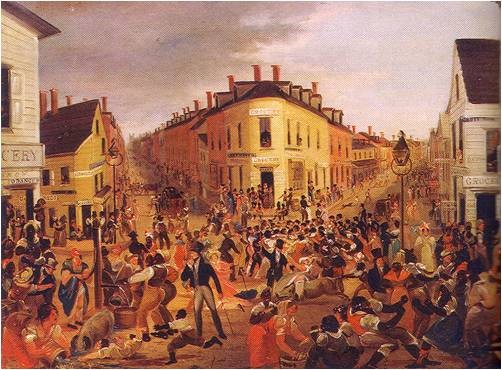
Leaflet summoning anti-slavery supporters to the meeting
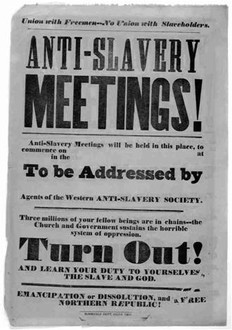
An old picture of Chatham Theatre
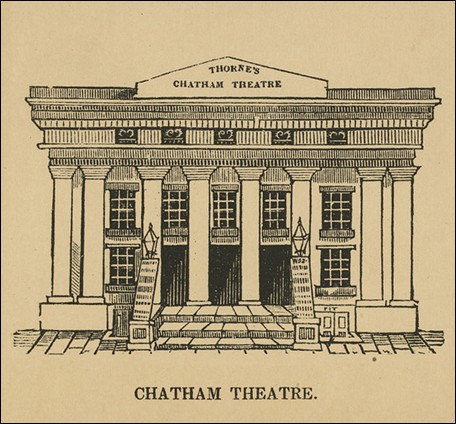
Newspaper excerpt of the events of 1834
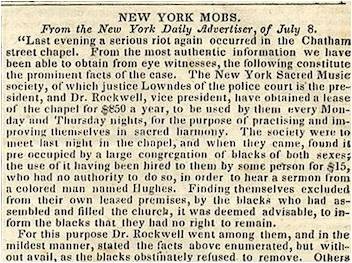
Historical plaque commemorating the Chatham Street Chapel
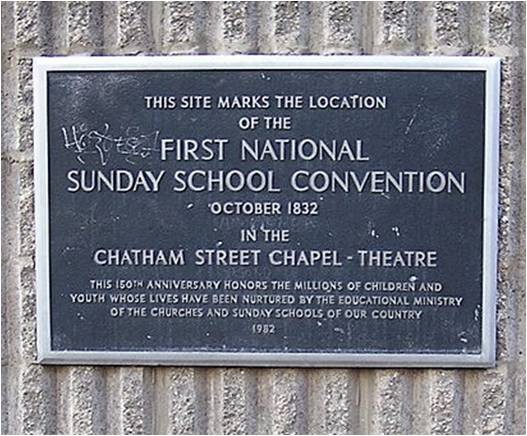
Map from the early 19th century showing the location of Chatham Street Chapel (point 159)
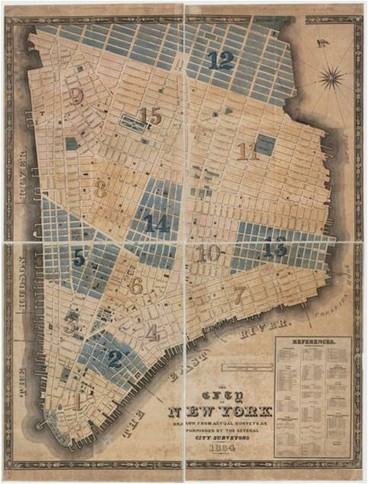
Backstory and Context
Text-to-speech Audio
The British Parliament had significant influence on the anti-slavery actions and campaigns in New York City during the 19th century. Following the Slavery Abolition Act in 1833, Arthur Tappan had organised a meeting to establish the New York Anti-Slavery Society. Tappan began organising and planning for the society earlier that year, but was waiting for a successful foreign abolitionist campaign to be able to launch his own. Arthur Tappan’s meeting was arranged for 19:30 on Wednesday 2nd October 1833, originally planned to be held at Clinton Hall.
The New York abolitionists were not the only ones to react to the British news, the pro-slavery supporters were deeply concerned about the impact the British politics would have on the status of slavery in America, and so, the anti-abolitionists met at James Watson Webb’s office on 1st October 1833, a day before Tappan’s scheduled meeting. Webb had openly demonstrated his support for anti-abolitionism and perceived the anti-slavery supporters as dangerous. To tackle the abolition ‘issue’, Webb had encouraged anti-abolitionists to meet at Clinton Hall for 19:00 so they could take action. Clinton Hall’s management staff were concerned over the potential unrest that could take place, and withdrew their permission for Tappan to use the Hall for his meeting.
Arthur Tappan’s abolitionist meeting was relocated to the Chatham Street Chapel. By the time Webb and pro-slavery supporters had learned about the new venue of the meeting, the New York Anti-Slavery society had their meeting and left.
In the early summer of 1834 both Arthur Tappan and Lewis Tappan had increased their anti-slavery campaigning, which fuelled the tension between the abolitionists and the anti-abolitionists in New York City. Over the month of July 1834, Chatham Street Chapel had experienced several protests from the anti-abolitionists. On the 4th of July a racially diverse Congregational Group had met to celebrate the emancipation of New York’s slaves (which had happened in 1827), angry anti-abolitionists stormed the Chatham Street Chapel to break up the celebration.
The celebration had been rescheduled for 7th July, but even on that day several rioters has stormed into the Chapel, eventually breaking up the celebration. The Chapel’s caretaker gave permission to the Congregational Group to use the Chapel’s large hall, which was usually used by New York Sacred Music society. The president of the society had accepted moving to a smaller room at the Chapel; however the caretaker did not inform the Music Society’s president that the Congregational Group consisted of African-Americans. When the Music Society members came and saw the African-Americans, they demanded for them to be kicked out. Both groups clashed and a brawl took place. The Congregational Group outnumbered the Music Society and was able to drive them away, however, not long after the African-American members of the group were arrested, and the rioters forced the remaining Congregational Group members to flee.
Two days after, Chatham Street Chapel became victim to another incident after a local New York newspaper had spread the rumour that a anti-slavery meeting was going to take place on the evening of 9th July.
The local newspapers from the time reveal that approximately two to three thousand pro-slavery supporters had met at Chatham Street Chapel to forcefully end the meeting.
Although the Chapel was temporarily used by the abolitionists, the short period of use had a significant impact on the events that took place in New York City. It can be found that Chatham Street Chapel became one of the key targeted areas during the rioting period in early July, and had been attack for three consecutive days. The structure was stormed by several thousand anti-abolitionists the news reveals and the rioters had caused significant damage to the location, and by the end of it, Chatham Street Chapel was hard to recognise.
Chatham Street Chapel has since been demolished and has been replaced by the Metropolitan Correction Centre. However, the memory of the Chatham Street Chapel continues to exist even today, as the location holds a historical plaque that honours the First National Sunday School Convention which took place at Chatham Street Chapel.
Sources
Burrows, Edwin G. Wallace, Mike . Gotham, A History of New York City to 1898. 1998.
Five Points, New York City Public domain image
https://www.loc.gov/resource/rbpe.13700400/
The New York Public Library Digital Collections
New York Daily Advertiser
Located at Metropolitan Correction Centre
Harvard University, Harvard Map Collection, G3804_N4_2M3_1834_C4
